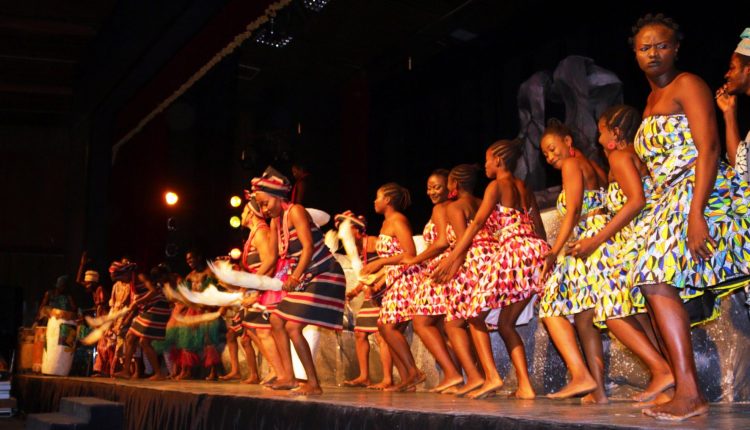How to adjudicate and award marks the Cultural Creative Dance
A) Scripting and Choice of Dance for the Cultural Creative Dance (10%)
-
A dramatized cultural dance should have a theme and a clear story line around which the dance pivots as it develops. The theme of the dance should grow from an established beginning to a conclusive end.
-
Relevance: a dance should seek to answer the following questions. Does the dance have a cultural source? Is the message educative?
-
Entertainment: Has the choreographer/composer moulded the words and movements and patterns such that the dancers and the audience will appreciate, enjoy, identify themselves with, and get the message of the dance with ease when the audience does not speak the language in which the message of the dance is communicated? The dance must establish the right mood for the occasion.
B) Choreography in the Cultural Creative Dance (70 %)
A dance ought to start live in the mind of the choreographer, who should then interpret and express the ideas, moods and situations through the art of movement, song and characterization.
-
Music (20%)
Is the dance enhanced by incorporating music and song or other effects that the choreographer may deem necessary when developing the dance? Such other effects may include singing and use of musical instruments. Songs help in conveying the message of the dance. They are sometimes used to command change in dance sequence. Voice projection and audibility are therefore very essential. Are the words clear and audible? Are the voices of the soloist(s) and dancers in harmony with mood and pace of the dance? Have the soloist internalized the meaning(s) of the song(s)
Instrumental accompaniment
How well do the sound of the instruments add to the total presentation of the song and dance? Do they hamper movements? How accomplished is the mastery of the instruments? Is there variety of instruments? How creatively are they used?
-
Dance (30%)
Tempo: The choreographer must determine the speed of the dance and music accompaniment. They should attempt to answer these questions. Does the pace live up to the situations and moods conveyed by words? For example, how does the ululation to welcome a warrior or new born baby differ from the solemnity of a burial ceremony? Are the movements in the dance fast or slow enough to render with ease? Is the dancing natural? If the dance is hurried, most of the times it appears mechanical. A right tempo is a crucial factor for an impressive dance.
Rhythm: Is the rhythm in harmony with the words and the tempo of the dance? How well have the dancers mastered the rhythm? Again, as in tempo, maintaining the right rhythm in the movements determines how well the dance has been mastered.
Movement: Appealing movements depend on how well both the tempo and rhythm have been synchronized. The choreographer should bring out the required message of impact. Movements are not only of the legs or arms bur rather of the whole body. They should be purposeful and relevant to the mood conveyed by the words. The movements should also be dynamic. They should help tell the story of the dance.
Formation: The choreographer should work out a fitting and interesting floor plan to be used by the dancers as they go through the emotions of the dance to avoid monotony and unnecessary crowding. The choreographer and the dancers should consider the ease with which dancers adjust themselves to the various formations. Do they arrest the interest of the audience? With ample time for rehearsals, the dance should be spontaneous even when complicated formations are created.
Pace: How does the pace help the message of the dance to develop? Are movements and formations well blended in terms of timing? Do the movements make the dance disjointed and dragging or do they make it flow? How well does the pace keep the mind of the audience alert?
Involvement: Are the dancers alert both mentally and physically throughout the dance? Do they respond well to the changing tempo, rhythm, movement, formations, etc? Do they identify themselves with and enjoy the dance? In short, are they engrossed in what they are doing without appearing as if they are struggling to concentrate?
-
Drama (20 %)
The dancers must bring out a clear story line with a beginning, middle and conclusion. This should be well infused into the dance. There should evidence of appropriate and distinct characterization. Characters must be clearly marked out and used to initiate, heighten and resolve the conflict in the dramatic plot.
The dance should be well rendered by the use of facial expressions, gestures and body movements.
The dance should be choreographed in such a way that props and other features are improvised and/or functionally used in the dramatic structure. There should be clear evidence of creativity and imagination.
C) Costume and Décor for the Cultural Creative Dance (10 %)
There should be good mixture of the set, costume and make up schemes so that the intended theme and situations of the dance can be brought home in a balanced manner without excessive simplification or magnification.
The costume should give an immediate impact suggesting the life, conditions and the personality of the dancers.
Make-up should enhance the facial expressions and body decorations should reveal the symbolism and representation of myths.
Costumes should endeavour to portray a positive cultural image e.g. avoid stereotyping. Whereas costuming may be appropriate, relevant and effective, it must observe the rules of decency required by the social decorum.
D) Overall Achievement of the Cultural Creative Dance (10 %)
This should be seen in terms of the degree of creativity which has gone into the making of the entire dance. This includes the choice of dance, choreography, costume and décor. Above all, the cultural creative dance should infuse the dramatic dance elements for effective communication.



Comments are closed.